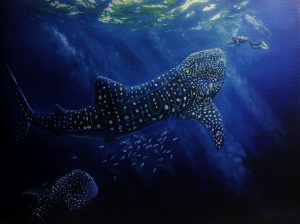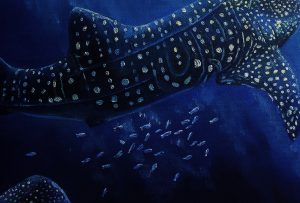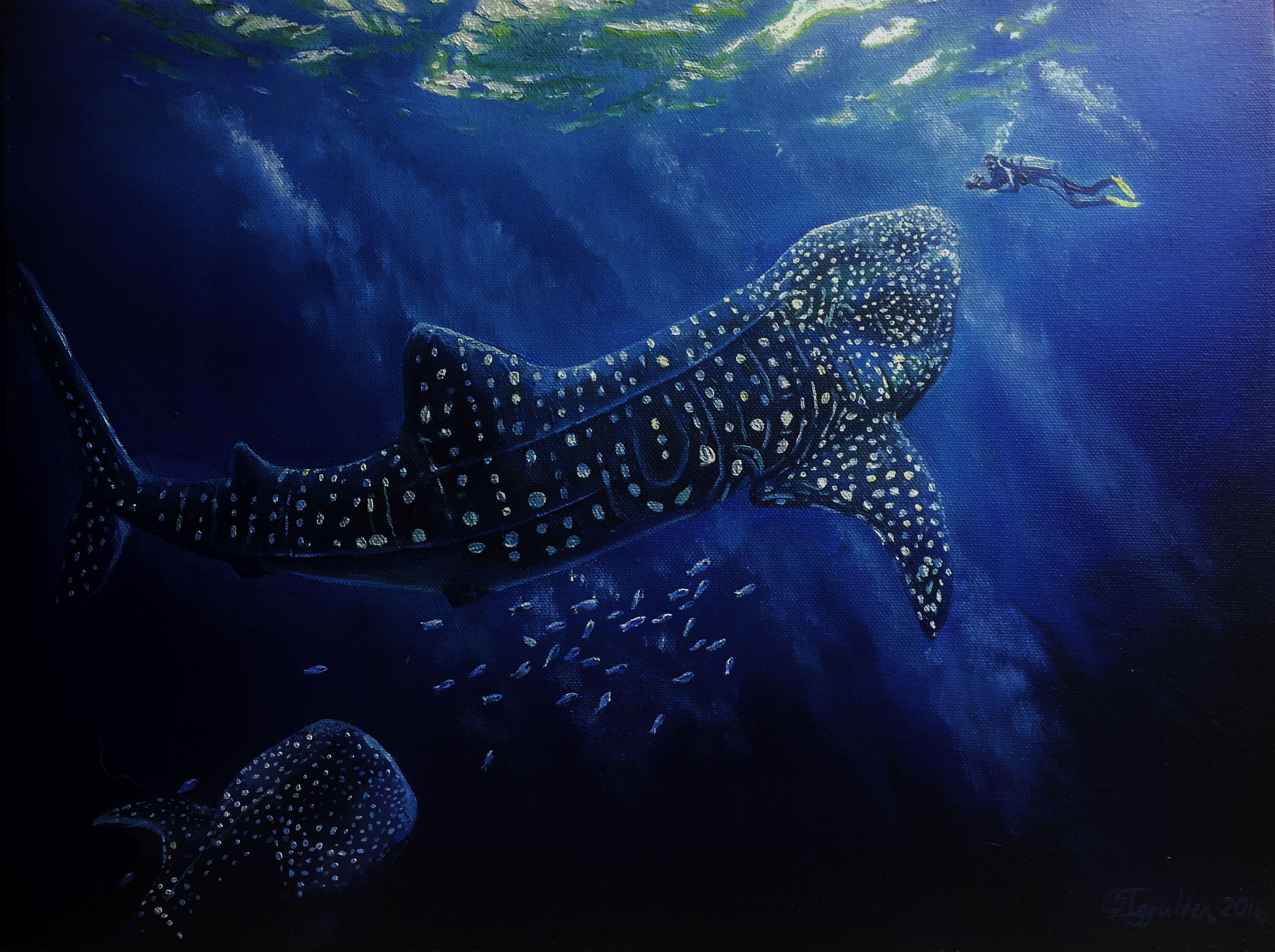
Elusive and mysterious
Ocean giants
Habitat
Most sharks prefer temperate climates, except for Greenland sharks, which live in the Arctic and Northern Atlantic. Some whale sharks have been found in colder North Atlantic water near New York, but most are found in warm, tropical waters such as the Indian and Pacific Oceans.
According to this National Geographic video, titled ‘Investigating the Mysterious Whale Sharks of Mafia Island,’ whale sharks help support small ecosystems, as they are often found with schools of smaller fish alongside them, presumably hoping to catch small morsels or plankton when the shark feeds.
My painting shows a school of smaller fish following one of the whale sharks:

Interestingly, this phenomenon has inspired local fishermen living on Mafia Island, Tanzania, to work alongside whale sharks to catch the fish without harming the sharks.
Deep divers
Although often found at the surface, whale sharks can dive further than 1000 metres. In one study, based in the Saudi Arabian Red Sea, researchers used three types of satellite-transmitting tags to track the movements of 47 whale sharks.
Their findings were impressive:
- The whale sharks made frequent deep dives to at least 500 metres (1,640 feet);
- Three of the tagged sharks made excursions below 1,000 metres (3,281 feet);
- The deepest dive they recorded was 1,360 metres (4,462 feet).
Distinctive and unique spot patterns
Feeding habits
Reproduction and longevity
The whale shark is usually solitary, however, it is sometimes found in schools of up to hundreds of individuals. These animals are found mainly in the open sea, but they sometimes come near the shore. Their age of sexual maturity and reproductive biology is unconfirmed, however, scientists presume that whale sharks are ovoviviparous, where the females incubate fertilized eggs inside her before they hatch, giving birth to fully formed live young. You can read more about ovoviviparity, and how it differs to viviparity, here. Each litter contains about 16 young, but litters of many more are possible. In the mid-1990s a female whose uterus contained nearly 300 young was caught near Taiwan. Like the other mysteries surrounding whale sharks, they have never been observed giving birth, and it is not known where this may happen.
It is thought that whale sharks are born between 40-60cm, but there are few sightings of individuals below 3m, and no one has yet determined where they go before reaching this size. However, one whale shark measuring just 38cm was found in the Philippines in 2009, suggesting it was a birthing ground and not simply used for feeding.
The gigantic size of whale sharks suggests they can live up to 100 years.
Whale Sharks, biodiversity, and conservation in the Philippines
Aside from its abundant natural mineral resources including gold and nickel (the country has the second largest gold deposit in the world), the Philippines is a biodiversity hotspot and a popular place for whale sharks to congregate; it is an archipelago consisting of more than 7,000 islands and is the smallest of the 17 megadiverse countries in the world. The Philippines covers only 2/100 of the total land area of the earth, yet 20,000 species of plants and animals have been recorded here, half of which are found nowhere else in the world. Read more on its biodiversity here.
Donsol, in the Philippine province of Sorsogon, has been identified as a whale shark hotspot, hosting one of the largest aggregations of whale sharks on Earth. 491 individual whale sharks have been identified at Donsol, this equates to 44% of all whale sharks identified in the country. Other large aggregations include Ningaloo Reef in Australia, Mexico, and Mozambique.
15 years ago, WWF Philippines partnered with Donsol and other tourism stakeholders to develop the Community-based Whale Shark Ecotourism Program and establish guidelines for whale shark interactions. Scientists are responsible for researching and studying individual sharks in an attempt to conserve them.
Endangered species
There are over 440 species of sharks in the world. These awesome creatures have outlived the dinosaurs, but many are now sadly threatened with extinction.
Indeed, whale sharks have no natural predators apart from people.
We need to remember that the ocean is their territory, not ours. Predatory species such as the great white, bull shark, or tiger shark, only attack if they confuse a person for their prey, usually fish or seals. It is best to bear this in mind if we choose to swim in areas of the ocean where they are present.
All sharks are vital to a healthy ecosystem
All marine life is essential to a healthy ecosystem and that of the planet as a whole. Sharks are vital as they maintain the species below them and are indicators of ocean health. The apex predators feed on weak and sick animals and ensure biodiversity.
Coral reef ecosystems, seagrass beds, and commercial fisheries have all declined due to the loss of sharks. Without sharks, larger predatory fish, such as groupers, increase in abundance in the coral reefs and feed on the herbivores. As the herbivores decrease, macroalgae increase and expand, leading to the loss of coral and the detriment of the entire reef system.
Majestic and awe-inspiring, yet vulnerable
I recently completed a four-week online course with the University of Southampton on ‘Exploring Our Ocean.’ One of the tasks was to upload an image, title, and description, to represent what the ocean meant to me; I uploaded my painting of whale sharks and titled it, ‘Majestic and Awe-Inspiring, yet Vulnerable.’ The wonders of nature surround us. For it to continue to inspire us, we should try to protect it from threats and exploitation.
Shark Week
